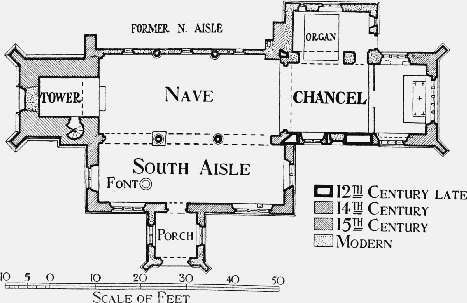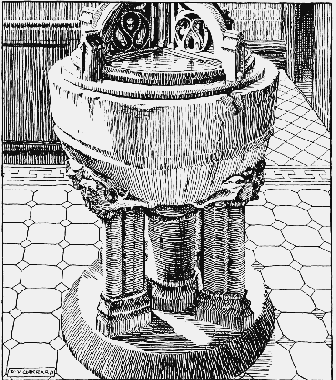A History of the County of Northampton: Volume 4. Originally published by Victoria County History, London, 1937.
This free content was digitised by double rekeying. All rights reserved.
'Parishes: Collingtree', in A History of the County of Northampton: Volume 4, ed. L F Salzman (London, 1937), British History Online https://prod.british-history.ac.uk/vch/northants/vol4/pp240-242 [accessed 19 April 2025].
'Parishes: Collingtree', in A History of the County of Northampton: Volume 4. Edited by L F Salzman (London, 1937), British History Online, accessed April 19, 2025, https://prod.british-history.ac.uk/vch/northants/vol4/pp240-242.
"Parishes: Collingtree". A History of the County of Northampton: Volume 4. Ed. L F Salzman (London, 1937), British History Online. Web. 19 April 2025. https://prod.british-history.ac.uk/vch/northants/vol4/pp240-242.
In this section
COLLINGTREE
Colentreu (xi cent.); Colintre (xiii–xiv cent.); Colyntrough (xiv–xv cent.).

Plan of Collingtree Church
Collingtree is a small parish of only 688 acres, about a third of which is devoted to pasture. It has a soil of clay and light loam, the subsoil being clay and sand, which produces good crops of wheat and barley.
A large two-story house at the south end of the village, faced with alternate courses of ironstone and limestone, has a panel in its dormer gable inscribed 'A.M. 1684'.
The manorial history of Collingtree is inseparable from that of Milton Malzor, and has been included under that parish.
The church of ST. COLUMBA consists of chancel, 28 ft. 6 in. by 14 ft. 6 in. with vestry and organ-chamber on its north side; clerestoried nave, 39 ft. by 16 ft.; south aisle, 12 ft. 8 in. wide; south porch, and west tower, 8 ft. 4 in. by 9 ft. 2 in., all these measurements being internal. The width across nave and aisle is 31 ft. A former north aisle was taken down in 1808, (fn. 1) but its arcade, walled up, was left standing.
Church
The building was extensively restored in 1871–3, when the chancel roof was renewed, and again in 1891 when the organ-chamber was erected, and in 1929 the roofs of the nave and aisle were restored, as much as possible of the old timber being reused. The walling generally is of coursed limestone, but the tower is of rubble. The chancel roof is slated, and that of the nave (which is of very low pitch) leaded. There are straight parapets to the chancel and nave, but the lead of the aisle overhangs. Internally the walls have been stripped of plaster, except in the chancel.
The pillars of the nave arcades are of late-12thcentury date, and the doorway in the south wall of the chancel is of the same period. The 12th-century church, therefore, consisted of a chancel and aisled nave, but it was largely rebuilt in the latter part of the 14th century, when the chancel was lengthened and the aisles rebuilt and widened. The tower and clerestory, the east window of the chancel, and one on the north side all belong to the early 15th century. A blocked doorway in the north wall of the chancel indicates a former chapel or sacristy.
The chancel has a chamfered plinth and diagonal angle buttresses of two stages. There are no lateral buttresses or strings. On its north side the chancel is covered for more than half its length by the organchamber and vestry. The four-centred east window is of five cinquefoiled lights with traceried head and hood-mould, and at the east end of the north wall is a three-light window of the same character. Both have double hollow-chamfered jambs, but the upper part of the east window has been restored. In the south wall are two pointed windows, the easternmost of three cinquefoiled lights with the mullions crossing in the head, tracery, (fn. 2) and hood-mould, and that to the west of two trefoiled lights with a quatrefoil in the head, and hood-mould with head-stops: these windows have double wave-moulded jambs and are placed high in the wall. Below the westernmost, but not connected with it, is a small rectangular low-side window, probably of the same date, the sill and head of which are chamfered and the jambs wave-moulded. Internally it has a flatly pointed rear-arch, and is now filled with a modern iron casement. (fn. 3) The late-12th-century priest's doorway, now blocked, has a plain round arch of a single square order, with hood-mould, springing from plain imposts, below which the jambs are chamfered. (fn. 4) East of this is a wide external sepulchral wall recess, with semicircular chamfered arch and hood-mould, apparently contemporary with the doorway. (fn. 5) Internally, in the usual position in the south wall, are triple sedilia under trefoiled ogee arches, the hood-moulds of which have head-stops and finials: the arches and dividing shafts and jambs are moulded, and the seats are on one level. There is no piscina. In the north wall, below the window, is a rectangular aumbry, and a little farther west the blocked doorway already referred to. There is a modern doorway to the vestry and an arch to the organ-chamber. The pointed chancel arch is of two hollow-chamfered orders, with hood-mould on the nave side, springing from half-octagonal responds with moulded capitals and bases. Close to the south respond, in the chancel wall, is a blocked rectangular opening about 3 ft. above the floor, which appears to have been a squint, (fn. 6) but there is no indication of it in the aisle. All the chancel fittings are modern. There is no screen.
The south arcade of the nave consists of three pointed arches of two chamfered orders, springing from cylindrical pillars with circular moulded bases, from a moulded impost at the east end, and at the west from a half-octagonal respond with moulded capital and base. The capital of the easternmost pillar has a square abacus and is plainly shaped below the moulding, but the moulded capital of the second pillar is circular throughout and the base moulding stands on a square plinth 10 in. high. The arches and the west respond are apparently part of the 14th-century reconstruction: the arches have a hood-mould on the nave side only. The north arcade is of similar design: the blocking masonry leaves part of the pillars exposed internally and in each bay there is a single-light trefoiled window. A blocked rood-loft doorway remains in the nave, north of the chancel arch.

Collingtree: The Font
The aisle is without buttresses and is lighted on the south by two square-headed windows of three trefoiled lights, one on each side of the porch, and at the east and west ends by similar windows of two lights. All these windows have hood-moulds and double-chamfered jambs, but are much restored. The pointed south doorway has a continuous double ogee moulding, and above it is a trefoil-headed niche. In the usual position is a piscina with shouldered head and circular bowl.
There are three plain square-headed two-light clerestory windows above the south arcade, but none on the north side.
The tower is of three stages divided by strings, and has a moulded plinth and diagonal angle buttresses of four stages on the west side. The four-centred west doorway is now blocked: it has a continuous-moulded arch, square hood-mould, and carved spandrels, and above it is a tall pointed window of two trefoiled lights and vertical tracery. The two lower stages on the north and south are blank, but in the second stage on the west side is a small square-headed opening. There is a projecting vice in the south-east corner. The pointed bell-chamber windows are of two trefoiled lights with quatrefoil in the head, and the tower terminates in a battlemented parapet. The lofty pointed arch to the nave is the full width of the tower, its three chamfered orders dying into the wall on each side. There are two steps up from the nave to the floor of the tower.
The fine late-13th-century font has a circular bowl on a central column with moulded top and base, and four moulded legs, or shafts, the junctions of which with the bowl are carved with grotesque faces and vigorous animal forms.
The oak pulpit and other fittings are modern. In the chancel is a brass tablet in memory of Horatio Woodhouse (d. 1679), who was rector for nearly thirty-seven years. (fn. 7) There is a memorial on the south wall of the aisle to four men of the parish who fell in the war of 1914–19.
There are five bells in the tower, a new tenor by Taylor & Co. of Loughborough having been added in 1915 to a former ring of four, the first three of which were at the same time recast. The old fourth bell is inscribed 'Sit Nomen Domini Benedictum', and is probably by a 15th-century London maker. (fn. 8)
The communion plate, which included a cup and cover paten of 1570, (fn. 9) was stolen in 1907, and was replaced by a new cup and paten in the same year. There is also a paten of 1919, and a pewter flagon.
Bridges, writing about 1720, says that the registers were 'consumed in a fire which broke out in the parsonage house some years ago and burned a considerable part of the town'. (fn. 10) In the earliest existing book, which from damp and other causes has become almost illegible, the earliest date that can be read is 1719 and the latest 1764. There is also a volume of marriages 1754–1812, and a fragmentary volume from January 1787 to 1811.
The churchwardens' accounts begin in 1638 and continue, with gaps, until 1854; there are constables' accounts from 1680 to 1795, and overseers' accounts 1733–1808.
The church possesses a copy of the Book of Homilies 1623, and imperfect copies (titles missing) of the 'Paraphrase' of Erasmus, and Jewel's 'Apology'.
Advowson
The joint advowsons of the churches of Collingtree and Milton Malzor were held as two moieties until some time after 1441, when Collingtree came to be considered the possession of Thomas Wake who had formerly held one of the moieties. It passed from the Wake family with the manor they held in Milton and Collingtree to Oliver Wood and followed the same descent as that manor until sold by Francis Foxley to Francis Hervey in 1606. (fn. 11) The Hervey family seem to have retained possession of the advowson until the middle years of the eighteenth century, since when it has changed hands several times. It was purchased in 1871 by Mr. Pickering Phipps, (fn. 12) and is now in the gift of the executors of Mrs. Phipps.
The Methodists have a place of worship in the village.
Charities
Church Estate. The rent of about 6 acres of land in this parish, amounting to £12 in 1935, is paid to the churchwardens and applied towards church expenses.
Reading room and Institute. By an indenture dated 1 December 1914 property was conveyed to the Peterborough Diocesan Trustees to be used by the inhabitants of this parish as a Reading room and Institute, and the rector and churchwardens were appointed trustees.